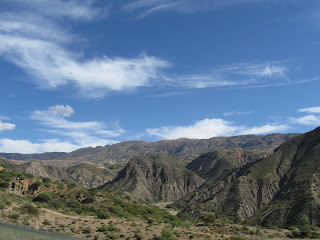The first morning in “Chiri (chilly in quechua) Asanquiri” brought a beautiful mountainous view, complete with impeccable visibility and sun rays skirting the decisively terraced fields of quinoa, beans and corn.

We gathered and walked to CECTFIA’s kitchen, on the way our ears being stimulated by the Charanga tunes being played by one of the students on the sidewalk outside the dorm. We entered the kitchen where the majority of the students were gathered, enjoying a simple, yet pleasant breakfast of the bread made the previous night and hot chocolate. After joining them, we were joined by the first year students in their classroom, and set about with our lesson.
Before continuing much further, the team feels it appropriate to explain in more detail what CECTFIA (Centro do Capacitatión Técinica y Formación Integral Asanquiri) is and what it does. Originally established in 2004 and sponsored by Save the Children Canada. It is a two-year school, providing an education primarily in agricultural skills, but also incorporating history, economics, computer technology, and principles of science and mathematics, with a focus on maintaining Andean culture. Currently, the school has ten college-aged students; five girls and five boys. Boys pay a per-year tuition of 200 bolivianos (around 30 US dollars) and the girls all attend on scholarships. The school year lasts 40 weeks and the students live in dorms at the school during the week. Almost all of the vegetables used by the kitchen are grown by students on grounds owned by CECTFIA. Students also help raise ducks, chickens, and guinea pigs for food. Every day, the students tend the crops and livestock. However, for the week the team was in town, the professor for level 1 students was on a trip, so Macario (the level 2 professor) asked if we could teach them about what we do.
In the morning, our lesson involved the basics of engineering, why we were here, turbidity and its significance as a water quality parameter, and hands-on testing of the water at the Center, with the occasional English lesson sprinkled throughout.

Soon, it was time for lunch, and we followed the students into the kitchen, ready to take on our first true meal at the Center. Lunch opened up with a very full bowl of soup with noodles, potatoes, vegetables, and meat. Thinking we were finished, the team was astonished to be presented with the second course, a fried egg, sliced tomatoes, onions, and carrots on top of a bed of rice and potatoes. Despite being delicious, lunch proved to be quite a test of willpower, simply from the sheer volume of food. About halfway through the meal we were all completely stuffed, and sat in awe as the students went back for seconds. Despite our stomachs urging otherwise, we were all able to cram the last bits of food down our throat and set about preparing for the rest of the day.


During the two and a half hour lunch break, the male students like to play soccer in the dusty drive that goes through the center. Feeling ambitious, Ben and Andrew decided to aim for the full experience and join in the fun. About half an hour later, feeling completely drained from the mountain air and constantly chasing the ball as it rolled down the side of a mountain, they had to admit defeat and sit the rest of the game out. Soon enough, the break was over, and it was back to teaching. For the afternoon, the team primarily taught about other water quality parameters.
At the end of the school day, we showed the students how to use aquarium test strips to test for certain parameters such as pH and nitrate levels, and we were pleased by how excited they became, and we were able to have them test several sites for us. We hope that this excitement will continue to permeate the students and interest in water quality is maintained, not only for the benefit of the students, but it will also greatly contribute to the sustainability of our project if students and instructors can test the Center’s water and interpret the data.

As night fell, we concluded our lesson and headed to dinner. Dinner consisted of potatoes, rice, fresh vegetables, and goat meat, served in huge portions by the school’s cook.
I

After dinner, we split up. Andrew and Ben went to go hang out in the male students dormitory, while Sara A. and Sara M. crashed in their room. Heterophonic melodies streamed from the boys dormitory. Between the five students, there were three sets of pan pipes, two charangas, a guitar, and a blaring radio in the corner. After some attempts to jam, Ben and Andrew eventually settled on trading songs back and forth with the students. “The Lion Sleeps Tonight” was easily the most popular song.
Completely pooped from constantly walking up and down hills during the day, the team had a short meeting and hit the hay.




































